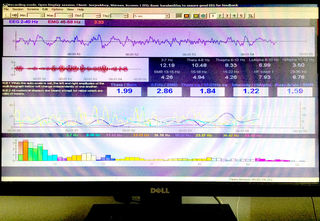Play
Salvation: Brain Biofeedback Begins
Ever wondered what playing a computer game with your brain is like?
Posted July 30, 2018
This is part six of a weekly serialization of chapters from Salvation, a section of my book describing the hope that effective treatment brings. Part one is here. For the first time in over five and a half years and after standard rehab had made little change to my injury, I received a "yes" to my goal of healing my brain. Concussion Is Brain Injury: Treating the Neurons and Me begins at the start of my brain injury journey; the Salvation section begins the journey of restoring my neurons. This week, I make tentative steps into possible hope.
Salvation
Chapter 9: Brain on Training Wheels
I woke up not feeling like a zombie.
I blinked. I looked around. Yes, I could see clearer, just like after my appointments with my psychologist. I effortfully raised myself. I was thirsty as heck. I craved water. My mind felt…like some cotton wool had been cleared out. By 2:00 p.m., I was fully awake. Really awake.
I had to do this again! I must remember to drink water after each session. But I couldn’t wait until the next day to try another session.
After breakfast, I grabbed my new Mind Alive device and its manual and hunted for another session to try. What to try? What to try? Oh, this one looked good. “Low Beta Perker with HRV” at 16 Hz, 2 Hz more than yesterday’s. I turned it on. Water! Sheesh. I went back and forth so many times from room to room, forgetting this, forgetting that, remembering, then immediately forgetting why I turned back. I didn’t need to go to a gym! Impatient to lift my brain out of its wool prison, impatient with myself for forgetting, I poured myself some water and returned. Time seemed to tick along slower than I felt. I felt like I’d been quick, only a minute, yet many minutes had inexplicably passed. It reminded me of how once a friend had said, “I can see you thinking.” That still made no sense to me. I shrugged off this confounding time differential between my inner clock and outer reality. I placed my water carefully on the table beside my chair and picked up the device before I sat on it. I turned it on again and succumbed to the light and sound show. Slight stimulation and no nap required.
I was in heaven.
Chapter 10: Biofeedback Begins and Lifeliner Ends

Tuesday, September 6, 2005. The trainer’s nail-bitten fingers scrubbed my ears clean with the gritty cleanser that rubbed sharp little pains into my lobes and the top middle of my scalp. I cringed inwardly. I wasn’t going to complain, though. I didn’t have the patience to endure cleaning a second time. My mental clock ticked down the minutes as she checked the impedance. Every second counted to me.
She explained the first screen of the brain biofeedback software on the ancient, fat monitor, its greyness a hulk on the heavy desk. I threw all my effort into following her words. She said that the first thirty seconds were assessment. Just sit, and the computer would read my brainwaves. The seconds clunked by, like drops of liquid lead hanging off the tip of a dropper unable to fall. She clicked the stop recording button, and I sagged into the back of the chair.
My trainer—in my head, I called her my “brain trainer”—explained we would now enhance SMR at CZ using a neurofeedback screen. The acronyms sounded strange. CZ? She explained CZ was where the electrode was on the top of my head. I resisted raising my hand to touch it, fearing I would disrupt the connection and it wouldn’t read my brainwaves anymore and she wouldn’t know it and all the work would be for naught. I swallowed nervously as she asked me if I was ready. Yes. She clicked Record, and indicators went up and down. I stared at the screen. How was I supposed to do this? How could my brain control those indicators? And what was I supposed to do with them again?
She told me to relax my muscles. I followed her orders and forgot to think. That worked!
Suddenly, she clicked Stop, and it was over.
“Good!” she said. She wrote down the numbers from the screen as I wondered what I was doing.
I crawled home late: 6:00 p.m. I ate a salad and collapsed in front of Canadian Idol with a bowl of popcorn. Yet email sang out to me, and I had to check it. No matter how dog-tired I was, I needed to see if anyone knew I was still alive and wanted to talk to me or say hi. An email from Dad awaited me. He had written a letter about his children for the award I was spearheading in his name, his seventieth birthday gift, and had described me as a writer. He desired my feedback. The word “writer,” his laudatory words emblazoned themselves on my heart.
The phone rang. Glenda said, “You need to call yourself a writer.”
“How can I? I don’t get paid. I can’t work as one.”
“Because you are.”
Oh.
“You have value,” Glenda told me. I nodded emptily at the wall.
The next day, I went to massage before my brain biofeedback appointment. My massage therapist kneaded and pushed my pain-filled muscles into some semblance of relaxation. The difference showed up on the computer when my brain trainer connected the electrodes to my ears and head and began recording thirty seconds of assessment. My scores were amazingly different! I felt chuffed. She told me that I was an excellent deep breather. Who knew? Until I arrived at the ADD Centre, I hadn’t seen the slow, sine curve beauty of my breathing on a computer screen. I was doing one thing right!
- To be continued next week.
Copyright ©2017-2018 Shireen Anne Jeejeebhoy. May not be reprinted or reposted without permission.


